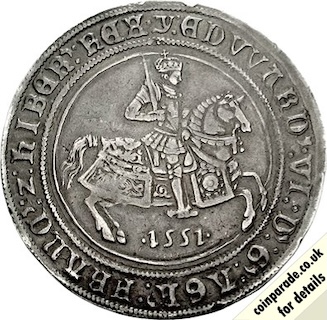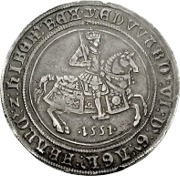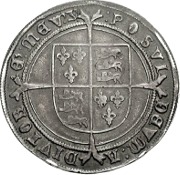
 The 1551 Crown - Edward VI
The 1551 Crown - Edward VI The Obverse shows the King on horseback with the date below. 'Fine Silver' Issue. There may be a mintmark above. The King would have been about 14 years old at the time (read more below).
The 1551 crown is from the Third Period (1550-1553), section Fine Silver Issue (1551-1553). The previous coins were the worst of the debased coins following the Henry VIII years and this series at least tried to make the coin look like it had quality. SCBC 2478.
It is one of the first English coins to show the date, although mint marks were present: 'y' for 1551 and a tun (a small barrel) for 1551-53.
The legend surrounds two inner circles. The coin is made of fine silver and has a diameter of 39mm.
 The Reverse is a quartered shield of arms with a long cross. The legend reads POSVI DEV A DIVITOR E MEV meaning "I have made God my helper".
The Reverse is a quartered shield of arms with a long cross. The legend reads POSVI DEV A DIVITOR E MEV meaning "I have made God my helper".Images used by permission of Classical Numismatic Group, Inc.
Mintage: Not known
Minted at The Royal Mint
More information (monarch, year, mint, country, category) can be found below coin listings.
Below are some coins currently being offered on eBay. As an eBay Partner, We may be compensated if you make a purchase.
List items on:
List items on:
Remember 1551 ?
1551 in Roman Numerals is MDLI. Monarch is Edward VI, the Boy King. The Regent is John Dudley. Silver sixpence and silver crown first minted.
Edward VI (1547-1553)
 Edward VI of England was born on 12 October 1537, the son of Henry VIII and Jane Seymour. He became King of England and Ireland in 1547 aged only 9 years old, having a Coronation on 20 February 1547. He was in the house of Tudor. Due to his young age, the realm was governed by a regency council led by his uncle Edward Seymour and then by John Dudley.
Edward VI of England was born on 12 October 1537, the son of Henry VIII and Jane Seymour. He became King of England and Ireland in 1547 aged only 9 years old, having a Coronation on 20 February 1547. He was in the house of Tudor. Due to his young age, the realm was governed by a regency council led by his uncle Edward Seymour and then by John Dudley.Edward died on 6 July 1553 (just 15 years old) after a serious illness and was buried in Westminster Abbey. Edward had decided that his first cousin once removed, the 16-year-old Lady Jane Grey, should become Queen. However, after his death his half-sisters Mary and Elizabeth desputed the succession and after only nine days Jane was removed from the throne (and subsequently executed) and Mary became Queen of England and Ireland.
The first coins issued in the reign of King Edward VI were in the name and some with the image of his father King Henry VIII. Later coins show the image of the boy King. There were still troubles with the debasement of gold and silver introduced by Henry VIII. There are many variations, some very nice coins but can be very expensive (up to six figures). Several Mints around the country were used.
Category: Crowns
The Crown is a very old coin, with origins dating back to Henry VIII. The English Crown first appeared in 1526. It was made of 22 carat gold ("crown gold") and has a value of five shillings (a quarter of a pound).By 1551, silver was being used to produce crowns, although gold was sometimes still used. The silver crown was quite large, being about 38mm and weighing about one ounce. Around that time many Europeans countries had similar sized silver coins which made them good for international trade as they were essentially interchangeable.
The metal used was 92.5% silver and the rest copper so as to make the coin harder. This hardness, together with a milled edge, made 'clipping' (which was cutting slices off the edge to steal some free silver) more difficult.
After the Union of England and Scotland in 1707 a new coin, the British Crown, replaced the English Crown and Scottish Dollar. The value was set at 5 shillings and the size was 38mm in diameter and weighed about 1oz as before.
Now more of a commemorative coin
Although the coin was always part of the British coin family, its large size made it unpopular for general circulation and the half-crown was favoured as the de-facto largest coin in circulation. The Crown was more-or-less relegated to a commemorative coin.
The British economy, especially after the World Wars, took its toll on the crown too. From 1816-1919 the crown was 0.925 silver, this was reduced to 0.500 silver in 1920 and in 1947 the Crown became Cupronickel (75% copper, 25% nickel). The size standardised at 38.61 mm and (silver crown) weight of 28.276g (1 oz).
Although not in current circulation, the Crown is still legal tender. After decimalisation in 1971 the Crown was officially valued at 25 pence. In the Eighties we had inflation which brought in higher denomination coins like the pound coin and the two-pound coin, so the Government decided that the crown needed to be restored to it former glory as biggest denomination coin and the crown was re-denominated to £5 in 1990.
Today the Crown is once again made in silver and gold, usually to satisfy collectors and investors. There is a little confusion with this as there are Gold Crowns which are worth £5 but there is another five-pound Gold coin from the sovereign family - see the article on Gold £5 Coin or Gold Crown?
Which Mint: The Royal Mint
The Royal Mint is the designated place for the UK to mint coins. It dates back well over 1000 years and is a Government-owned company. Formed in the reign of Alfred the Great about the year 886, during the period 1279-1812 it was generally referred to as The Tower Mint as it was housed at the Tower of London. The Master of The Royal Mint has included famous figures such as Sir Isaac Newton.
Since 2010 it has operated as Royal Mint Ltd, a company owned by HM Treasury, under an exclusive contract to supply all coinage for the UK although it also produces medals and coins for other countries. It is currently located at Llantrisant, Wales.
Country of Origin: United Kingdom
The United Kingdom (UK) is the Union of England, Scotland, Wales and Northern Ireland. It is often refered to as Great Britain (GBR). It has a long, rich history. The orignal coinage was Pounds, Shillings and Pence but since decimalisation on 15 February 1971, it is £1 = 100p, that is One Pound = 100 pence. The coinage of the UK is also a long history, the Royal Mint being established as long ago as 886AD when coins were hammered. Today there is perhaps 30 billion coins in circulation, and many (numismatic) collectors coins and sets are issued frequently in gold, silver and other metals.








